For the collective four years I have attended the University of Science and Arts of Oklahoma, I haven’t spent much time in our library. Now, I’m asking myself “why?” I met with the director of Nash Library, Kelly Brown, who has worked for the University for fifteen years. I could tell just upon emailing her how excited she was to dive into the archive section and help me through this course. As I walked into her office, I noticed a small stack of books already laid out on her desk and the moment I sat down, she was already throwing ideas at me.
Kelly continued to tell me she had to run a report in order to find the oldest book in our collection. Unlike many other libraries who probably have books from the 1600’s, or perhaps earlier, we only go as far back as the early 1800’s. Notes on the State of Virginia by Thomas Jefferson was our oldest book.
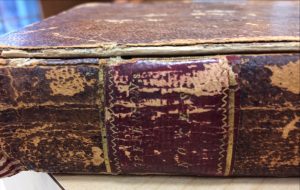
By looking at the cover, there was no way of telling what it was. Printed on the binding of the book, clearly faded, were the words “Jefferson,s Notes.” I realize that’s a comma and not an apostrophe, but for the sake of how it was printed on the book, I did not want to correct anything. The book was printed in New York and was printed for and sold by T.B. Jansen & Co.
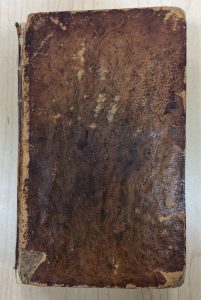
Unfortunately because of the condition of the book’s cover, and lack of reader use on the inside, there was no recollection or idea as to who owned it before we acquired it. While I cannot tell the history of who owned it before we received it, I can explain briefly about the time period and why Jefferson wrote the Notes. The completed work of notes was actually composed in 1781 (our book is the fourth American edition). The book is simply what it sounds like – notes over everything about the state of Virginia at this time. Items such as the history of the state, society, politics, education, religion, slavery, law, and agriculture filled the pages of this book. According to the Encyclopedia Virginia website, this book “established Jefferson’s international reputation as a serious scientist, a man of letters, and the principal spokesman for his ‘country'”1.
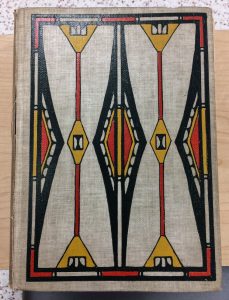
The Indians’ Book was the book I chose to share about which showed evidence of reader use. The beautifully crafted book is full of Native American songs, collectively put together by Natalie Curtis (Burlin) in 1907. Natalie was a New York City musician and chose to go on a journey to record native songs and dances from different Native American tribes.2 As our librarian, Kelly handed me the book, I noticed how colorfully illustrated the cover was and how the design set it apart from other books – making it obvious that it was Native American. The reason I stuck with this book was because of the history it holds dear to the heart of my college.
Here at the University of Science and Arts of Oklahoma, we have a stunning bronze statue that stands in the middle of what we call “The Oval.” Te Ata, otherwise known as Mary Frances Thompson (Fisher), was a traditional Native storyteller as well as an attendee of the Oklahoma College for Women (OCW). OCW became the University of Science and Arts of Oklahoma – our state’s only liberal arts college and here we are today – continuing her story in such a modernized world.
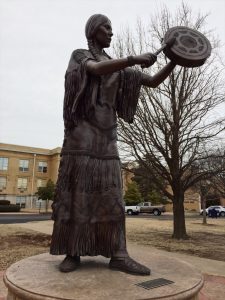
Te Ata’s statue is one many students, faculty, and staff pass by on a daily basis, but many most likely do not know a lot about. This is something I wish to learn more about.
The Indians’ Book was a great choice because it was one which was gifted to Te Ata on Christmas of 1929 and eventually she gifted to our university. In the front cover, there is her signature. On the next page there is an ink illustration of a Native American head and by it is a signature, Chief Max Big Man – from the Crow Tribe of Montana. Te Ata is iconic to this school and adds to the history.
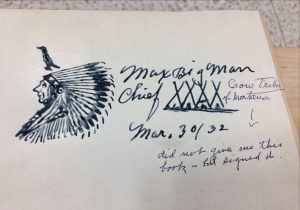
Along with the statue, our primary auditorium is named after her. She only wrote a small amount in the book, here and there mentioning “great song” or “wonderful book” or noting a passage was pertaining to the “spiritual side of the Indian.” We aren’t sure who owned it before Te Ata or even who gifted it to her, but she kept the book in prime condition. The look, the smell, the feel of it all feels used, but not horribly used or abused as some old books are.
Another special gift to our university was a hefty donation of 10,000 books by Dr. Richard Lowitt. He was previously a Regents professor here at USAO and taught a mixture of American History and American Literature – which explains his plethora of books in his personal library. He collected these books through his many years of teaching, as he will turn 95 in this coming February. Along with his experience of teaching, he collected the books because he knew the importance of these subjects and simply liked the topics. Dr. Lowitt first asked the University of Oklahoma if they would like his books, and upon turning him down for their overloaded library, we happily took them when he asked us. Of the 10,000 donated, Kelly is in the process of selling about 4,000 through Amazon and the other 6,000 are being worked into our library’s collection.
All three of these questions/prompts only hyped me up more to dive into the history of the stories behind these written words and those who owned them beforehand. I cannot wait to learn more and share more as I spend more time researching the past these books hold. ✥
Footnotes
1. Notes on the State of Virginia
2. Natalie Curtis Burlin, ethnomusicology and folklore
I’m hyped to read more of your blogs/posts!